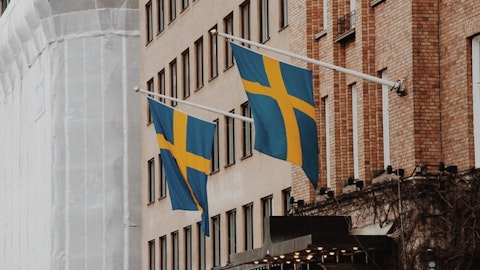Telefonaktiebolaget LM Ericsson (publ) (NASDAQ:ERIC) Q2 2023 Earnings Call Transcript July 14, 2023
Telefonaktiebolaget LM Ericsson (publ) beats earnings expectations. Reported EPS is $0.07, expectations were $0.05.
Peter Nyquist: Hello, everyone, and welcome to this call covering Ericsson’s second quarter 2023. With me today, as usual, I have our President and CEO, Börje Ekholm; and our CFO, Carl Mellander. As usual, we will start this with a presentation and end with a Q&A session. And then in order to ask questions, you need to join the conference by phone, remember that. Details can be found in today’s press release and on our website, ericsson.com/investors. And please advise that today’s conference is recorded. But before handing over to Börje and Carl, I would like to read the following: during today’s presentation, we will make forward-looking statements. These statements are based on our current expectations and certain planning assumptions, which are subject to risks and uncertainties.
The actual results may differ materially due to factors mentioned in today’s press release and discussed in this conference call. We encourage you to read about these risks and uncertainties in the earnings report as well as in the annual report. With that said, I would like to leave the word to you, Börje. So please, Börje.
Borje Ekholm: Thank you, Peter, and good morning, everyone. Big thank you all for joining us for this second quarter report. I’m happy to present a quarter where we continued to execute on our strategy to build a stronger and more profitable Ericsson for the long term. Based on our strategy and our strong position, we’re able to deliver a solid quarter despite challenging market conditions. We see a changed business mix with North America representing one of the lowest shares we’ve seen in many years. But on the other hand, we see India growing very, very fast. Our strategy, as you all know, is focused on 3 priorities: the first one to bolster our leadership in mobile networks; second is to grow our Enterprise business; and thirdly, drive a cultural transformation of the company.
Mobile networks continues to be the bedrock of Ericsson. With about half of the world’s 5G traffic outside of China carried through our radios, we are a leader in the market, And we remain fully focused on continuing to strengthen this leadership position. In parallel, we’re using our expertise in advanced cellular networks to expand into the fast-growing enterprise market and that will substantially increase our addressable market, diversify our portfolio and puts us on a higher growth trajectory. In our platform business, we’re developing new ways to monetize 5G’s unique features like speed, latency, et cetera. Operators and enterprises are showing great interest in this area and it will allow them to differentiate their offerings and start to develop completely new use cases.
We’re also continuing our relentless focus on enhancing our compliance program to make sure that it’s fully embedded throughout the company. With that, let me now go through some of the key takeaways from the quarter. As we’ve said before, 2023 is a choppy year and Q2 developed much in line with our expectations and what we have said to the market. We continued to execute with discipline and focus. Our overall sales declined by 9%. The decline in Networks was partially offset by organic growth in Cloud Software and Services and a 20% organic growth in Enterprises. The EBITA margin, excluding restructuring charges, was 5.7%. In Networks, India continued its strong development and network rollout. And by delivering a record build-out, we now have the leading market share in India as well.
As expected, we saw a softening in other markets, primarily front-running 5G markets and that includes, of course, North America, and that’s something that we have discussed with you before as well where we see the build-out pace being moderated, but we also see customer inventory levels being rebalanced. And despite this big mix shift between our geographies, we could deliver a Networks gross margin of over 39%. In Cloud Software and Services, we continued to execute on our revised strategy to reach profitability, and we are on track to reach at least breakeven for the full year. In Enterprise, we saw a strong growth in Enterprise Wireless Solutions, and we’re also happy to see a positive EBITA in Global Communications Platform. And we saw sales from Vonage current communications APIs offerings to grow by 19%.
And you all know the importance of IPR for our — or to reach our long-term financial targets. And of course, that’s built upon our strong technology leadership position. And in the quarter, we were able to secure another important 5G licensing agreement with a device vendor that puts us well on track to further strengthening our IPR revenue base into 2024. We’re also addressing areas that’s in our control. So when we are in the market, as we are today, that’s challenging. We are intensifying our efforts on the cost-out initiatives and we are well on track to reduce our annual run rate by at least SEK 11 billion, and this will start to positively impact the P&L over the coming quarters, already now in the third quarter, but have full effect during 2024.
The overall performance in the quarter is really a testament to the underlying strength and resilience of our business and our ability to adapt and execute in a challenging macro environment. With that, let me hand over to our CFO, Carl Mellander, to really go into the numbers. Carl?

Copyright: bluebay / 123RF Stock Photo
Carl Mellander: Thank you, Börje, and a very good morning to everyone on the call. So as you saw this morning, the results that we published came out according to our expectations and per the guidance that we had issued in connection with the first quarter report. I’ll start by having a look at the development in the different market areas and then comment on some of them, if we go to the next slide, please. So looking here at the geographies, as Börje said, we saw rapid 5G rollout in India. It’s very clear. And the Network sales in India doubled year-over-year. This resulted in an organic growth in our market area called South East Asia, Oceania and India by 71% organically year-over-year. Our strong growth in this market area partly offset the softening, as we have discussed many times, in the North American market.
This was as expected. And the decline there in North America was 42% year-over-year organically due to lower CapEx spend, as anticipated, and also reductions of customer inventory following the very high investment levels in 2021 and 2022. However, Cloud Software and Services grew 10% in the North American market area, driven by 5G. In Europe and Latin America, which actually was the largest market area for us in terms of sales in this quarter, we saw a decline in Europe by 6% organically. But in Latin America, we recorded a growth of 3% organically mainly driven by additional 5G deployments in Brazil. And overall, this resulted in a 3% decline for the market area as a whole. If we leave this and then zoom in on how all of this came together in the group P&L.
So our reported sales in the quarter were SEK 64.4 billion. That is a decline by 9% organically due to all the reasons discussed on the previous slide. So I will not repeat that, but let me jump directly to gross margin. Gross margin, excluding restructuring, declined by 390 basis points year-over-year to 38.3%. And this is primarily due to the lower sales and lower gross margin in Networks due to the — this continued change in business mix, combined with large rollout projects, which come with initially lower margins because there’s a large portion of service content in those but they also improved the margins over time. In gross margin, we also see positive impact from the increased IPR revenues. IPR revenue increased by SEK 1.7 billion year-over-year to SEK 3.2 billion in the quarter.
And this increase was mainly driven by 1 contract signed in Q4 2022, but also the new licensing contracts signed in this quarter that Börje already mentioned. So our Q2 numbers, I should say, that also include revenue for the past unlicensed quarters in accordance with this new IPR contract. Cloud Software and Services gross margin, excluding restructuring, was 33.9%. This is a slight increase of 40 basis points year-over-year, supported by higher sales, but also improved delivery performance and the higher IPR revenues helps as well in this segment. And then in Enterprise, gross margin, excluding restructuring, decreased to 46.3% from 52.8% And this is really due to the consolidation of Vonage into Ericsson with a lower gross margin than the remaining part of the Enterprise segment.
Further down the P&L, then R&D and SG&A increased year-over-year. And aside from the FX impact here, which stands for about 25% of the increase, this mainly comes from the addition of Vonage, but also further investments in R&D as well as go-to-market activities in Enterprise Wireless Solutions. So all in all, group EBITA margin, excluding restructuring, was 5.7%, which is again in line with our expectations. And the year-over-year decline that you see, again, mainly impacted by lower gross income from Networks, but also the increased investments that we undertake in Enterprise and the consolidation of Vonage. Can also mention restructuring charges, SEK 3.1 billion in the quarter. This is mainly for redundancy costs related to the cost-reduction activities.
We still estimate restructuring costs to amount to SEK 7 billion for the full year. And as a result of this amount of restructuring as well, combined with the other factors in the P&L, we reported a net loss this quarter of SEK 0.6 billion compared with net income last year of SEK 4.7 billion in the corresponding quarter. Also want to mention that if we look on a rolling 4-quarter basis, sometimes that’s a better metric, then our EBITA margin was 9.1%. And as you know, the long-term target is 15% to 18% EBITA margin. We can move to the next slide to have a look at cash flow now. So cash flow from operating activities decreased to SEK 2.9 billion from SEK 6.3 billion, SEK 2.9 billion negative. And this is mainly due, of course, one, to lower EBIT, but also increase in working capital year-over-year.
And why did working capital increase? Well, it’s primarily driven by the business mix shift, the same aspects that impact the P&L, including this very large rollout projects, which have longer order-to-cash cycles than the front-runner 5G markets have had. So this is an impact on working capital, but temporary. And also cash flow was impacted by the payment of the fine related to the resolution with the U.S. Department of Justice of SEK 2.1 billion, which was provisioned in an earlier period but paid in the second quarter. We saw a small reduction of inventory. So that’s good to see inventory coming down. This is driven both by the components coming down and finished goods as well. And of course, this supported cash flow in itself. So a result of all of this is a free cash flow before M&A at minus SEK 5 billion.
To that, we can add M&A activities, SEK 0.9 billion, which was a result of Cradlepoint’s acquisition of Ericom, which we have announced earlier. And we do that acquisition to strengthen the 5G offering in the Cradlepoint or Enterprise Wireless Solution portfolio. Rolling 4-quarter basis, I return to that, that’s on free cash flow, was SEK 6.4 billion, which corresponds to a 2.3% of net sales, again, compared to a long-term target of 9% to 12%. And as I believe I mentioned also in the previous quarter, of course, we are not satisfied with where we are in terms of cash generation and this really remains a key focus area for us. For Q3, we don’t expect significant changes in working capital. But in the second half of 2023, we do expect a positive free cash flow before M&A with Q4 as a strong cash flow quarter in line with our historical patterns.
I can only — I also mention here that we paid out the first dividend installment in the quarter as well, amounting to totally SEK 4.6 billion. And summing that up, closing net cash position then ended up at SEK 1.9 billion, while gross cash is at SEK 35.7 billion. So here, we continue, of course, to execute on the funding plan we had to refinance the maturities we have in the debt portfolio and add also new sources. And among many activities in corporate finance, we have launched a commercial paper program in the quarter, and we signed an initial facility for USD 0.5 billion for general corporate purposes as well. Finally, for me, let’s look at the outlook for next quarter, the third quarter 2023. A couple of items to pay attention to. First of all, we expect gross margin for Networks to be in the range of 38% to 40% in the third quarter with very similar trends and mix as we saw in Q2.
We have less IPR revenue due to catch-up revenue in Q2, but on the other hand, some support from cost-out. OpEx, and here we exclude Vonage, typically decreases seasonally with SEK 0.7 billion from Q2 to Q3. But of course, as usual, we have large variation between quarters. We expect now cost reduction activities to start to have an effect in Q3, but still rather small but increasing over time quarter-by-quarter going forward. It’s going well in terms of executing on cost-out, and we are aiming at a run rate saving of at least SEK 11 billion by end of this year, of which 45% is related to OpEx. For Cloud Software and Services, we expect Q3 EBITA to be in line with Q2. And we will, according to our estimate here and we’re committed to that, reach at least breakeven for full year 2023.
Group EBITA margin, again, excluding restructuring, of course, in Q3 is expected to be in line with or slightly better than Q2. Again, similar trends, similar business mix, early benefits of the cost-out execution and then followed by a seasonally stronger fourth quarter. Thank you all for that. And with that, I hand it back to you, Börje.
Borje Ekholm: Thank you, Carl. So our strategy is really working, and we are leveraging our technology leadership in mobile networks as well as taking the critical steps in our ambition to grow in enterprises. As we look ahead, I think it’s important to single out that the fundamental driver of Network CapEx is really the continued data traffic growth. And we see that 5G really continues to grow very fast. We currently forecast 5G subscriptions to be about SEK 1.5 billion by end of 2023 and reach SEK 4.6 billion by 2028. We also see that the data traffic in the network continues to grow. And we also start to see new type of use cases, call it fixed wireless access, but we’re also starting to see enterprise use cases. So data traffic is growing.
And with the operator’s desire to meet the, I would say, the user’s expectation for network quality, but adding on cost and energy efficiency, and you know CO2 footprint starts to be more and more important, we see that, that will stimulate further investments. In addition, we see that 3/4 of all base station sites outside of China are not yet updated with 5G mid-band. So this, in combination with the migration to 5G stand-alone, will basically continue to drive the need for investments in 5G networks around the world. So we are confident that the market will recover, and that’s what we have said for several quarters. And as a consequence of these factors, of course, the exact timing of the recovery will be in the hands of our customers. But we are encouraged by the discussions we’ve had with several customers, where we see a recognition of the need to strengthen capacity in the network.
That said, we expect a gradual recovery towards late in 2023 and then improve in 2024. When that happens, Ericsson is really well positioned to benefit. And based on an expected recovery of the mobile network market, we remain focused on reaching the lower end of the 15% to 18% EBITA margin target in 2024. So to sum up, we continue to navigate the current environment with discipline and focus. We’re delivering on the Cloud Software and Services turnaround. We do portfolio adjustments. We will enhance the R&D productivity. We see IPR revenue growth. And we will continue to execute on our cost-out reduction — or cost reductions. And of course, in an uncertain market to really impact what we can impact that’s under our control is critical. So we have accelerated our efforts on the cost-out like we spoke about last quarter in preparation for a tougher market condition.
But we remain ultimately focused on our key strategic priorities: to drive technology leadership in mobile networks, expand or leverage the capabilities we have for cellular networks into expanding in the enterprise space that increases our addressable market and growth potential, and finally, to strengthen our culture. With that, I would really like to thank all the fantastic people in Ericsson who has made this position we’ve achieved today possible. A big thank you to all of you. With that, back to you, Peter.
Peter Nyquist: Thank you, Börje. So it’s now time for the question-and-answer session. [Operator Instructions]. If you are streaming the webcast, please mute the webcast audio whilst asking question to minimize any kind of sort of audio feedback.
See also 10 Best Marine Shipping Stocks to Buy Now and 25 Cheap Things to Do in Retirement.
Q&A Session
Follow Ericsson L M Telephone Co (NASDAQ:ERIC)
Follow Ericsson L M Telephone Co (NASDAQ:ERIC)
A – Peter Nyquist: So our first question now comes from the line of Aleksander Peterc.
Aleksander Peterc: I will just have a first one, which is a bit dense and then a very small follow-up, if I may. So my first question is really there’s a disconnect between your guidance of 15% EBITA margins in 2024 and the consensus which is currently at 11.5%. Now the jump in EBITA that is implied in your ambition or guidance is almost SEK 20 billion now, and that’s almost double your planned annual cost savings run rate, which is SEK 11 billion, some of which will already be in the ’23 numbers — already in the base. So I’d just like to understand where exactly is consensus getting it so wrong? Is it the market mix? Do you see much more substantial growth into 2024? Where are we all getting it so badly wrong?
Borje Ekholm: Maybe I can start. The fundamental premise for our targets for 2024 has been the — what we see as a recovery in the market, and you have to factor that in. And that, to me, is of course — it’s impossible to say exact timing when that will happen. But we’re very confident it will happen and that will provide basic support for the market. Then our cost-out ambition is at least SEK 11 billion. So we should be reaching that, that will provide support. In addition, there are a couple of things, which I’m not sure is factored in. One is IPR revenues. That, we see will continue to grow into next year. We also see that the fundamental turnaround of our Cloud Software and Services will provide a strong support next year.
And we will also see some portfolio adjustments that we have already spoken about before to provide support. So yes, we do continue to focus on reaching that target for next year and we’ve said we should be in the lower end of that range. We are focused on reaching that, and that’s why we’re trying to be as aggressive as we can on the items we can control right now.
Peter Nyquist: You had a second question, Aleksander as well, right?
Aleksander Peterc: Yes, just a quick follow-up. I do feel that your message for the recovery has slipped by about a quarter. You mentioned before, I think in Q1, we spoke of a gradual recovery in the second half. And now basically, third quarter is very similar to the second with a slight improvement in EBITA margins, but not that material and the real recovery is in Q4 so — or then seriously in 2024. So can you tell us which markets are a little bit weaker than you previously thought? Is it a longer slump in the U.S. primarily or anything else?
Peter Nyquist: Börje?
Borje Ekholm: We see overall a softer market that we’ve said since the end of last year. And of course, it’s very hard to predict the exact timing when customers will buy. What we see is the network quality around the world, actually in many markets, starting to deteriorate. And of course, that provides the basics for the investments. Exactly when that’s going to happen, I feel that it’s really in the hands of the customer. So it’s in the hands of their view of capital market, their view of prospects in the business for increasing revenues, et cetera. So that’s little bit difficult to say. With our current visibility, we believe it’s realistic to plan for that to happen later in 2023. Is it later or earlier than we have said before?
I don’t really know. If anything, probably fair to say that it’s slightly later. But it’s not a dramatic change in outlook that we try to say already last year. In the end of last year, we spoke about the slower build-out pace than we expected. We spoke about the inventory adjustments our customers are making. Of course, as this quarter continues, there will be less and less of the inventory adjustments. So that will provide a support for the market recovery and kind of looking better towards the end of the year.





